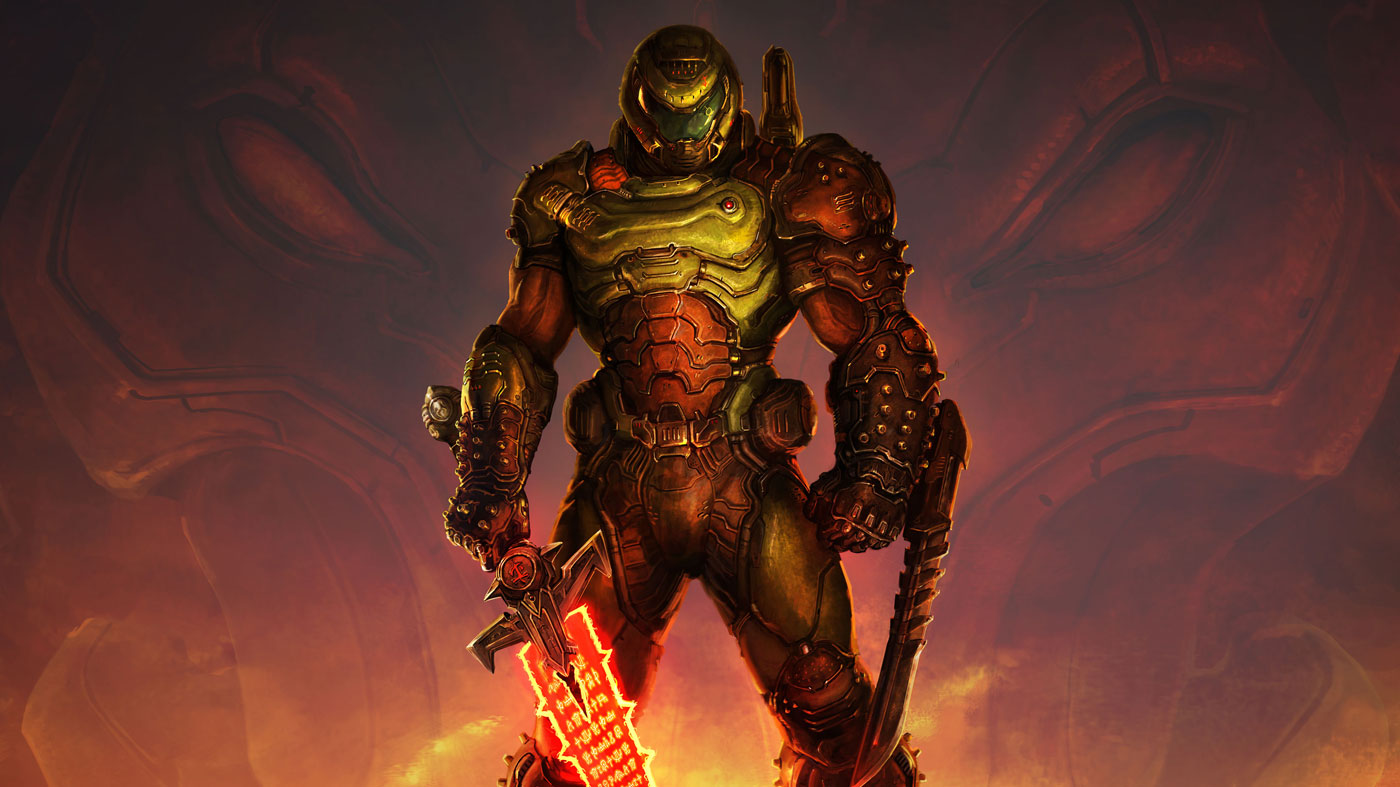Doom is Eternal, or so Bethesda says and maybe they’re onto something. The franchise turns twenty-seven this year, and it’s hard to deny not only it’s impact, but that it clearly has staying power. Even after the then-cataclysmic shift in direction that Doom 3 took, Doom as a brand was able to bounce back with the fast and frantic 2016 reboot. Now, boldly daring us to wonder what else they could do, iD Software has come to the gates of Hell, all guns blazing with Doom Eternal. More than just Doom 2, Eternal does everything you’d expect and more to effortlessly eclipse its predecessor.
Doom is Doom, it’s never been about the story, but Eternal gives it a red hot go anyway. At its most basic level, Doom Eternal follows the Doomslayer as he continues his quest to prevent Hell’s demon hordes from invading Earth. This time around, however, a pseudo-angelic race of supreme beings called the Makyr has taken notice of the Doomslayer and has a similar stake in seeing Earth lose. So, in his infinite state of legend, Doomslayer must do battles with the forces of both Heaven and Hell to keep Earth safe once more.
From the get-go, Doom Eternal throws you into things with little to no preparation. Don’t expect to have that cliff-hanger from 2016’s Doom to be touched upon until well into the story. Don’t expect to understand what’s going on in the opening hours without delving into the (fantastic) codex. I surmise that it’s hard to give a story to a game as rooted in its simplicity as Doom, but if you stick with Eternal it all comes together rather nicely. It ultimately plays things safe, but there are some nice little retcons here and there that I appreciated as a long-time fan that dovetails beautifully into a simple but satisfying ending.
If you played any of the old Doom games or even the latest, you’d have a pretty good idea of what to expect from Doom Eternal. The game takes everything established in the 2016 reboot and attempts to expand on it in practically every way without eschewing anything from the previous game. It’s an admittedly rare but satisfying feeling to play a game like Doom Eternal and feel that nothing was held back – that nothing is glaringly absent from the overall experience. It’s one of the most feature-complete and robust AAA experiences I’ve had in a long time and while satisfying leaves you with a persistent longing far past when the credits have rolled.

Doom Eternal carries on from its predecessor, offering an unrelenting high-speed experience that plays out almost like a rhythm game than a first-person shooter. There’s a clear-cut sense of flow to the action in Eternal, and it’s all pinned on a simple design fundamental – that you must always be moving and still be managing yourself and your arena with gusto. If you’re low on health, you must advance towards your enemies to perform deadly glory kills to recover it (you can see 20 of our favourite glory kills here). Ammo? Make sure you’ve got enough fuel to chainsaw an enemy or two to replenish that. All while avoiding incoming fire from massive hordes of demons.
And when I say massive, I mean it. Not content with just delivering a simple and straight Doom II, Doom Eternal more than doubles the pool of enemies that you’ll face in battle. So many creations are brand new, while others have been brought back from other Doom games but with modern twists. Even enemies in the previous game have been given something new or different in the way they behave to better gel with Eternal’s new systems. My personal favourite is the Arch-vile, whose mere appearance disrupts your flow of combat and forces you to make quick decisions amid battle.
Most enemies can also be dismembered or disabled in some way to make things more manageable, adding another layer of strategy to battles. The Arachnotron’s turrets can be disabled to stop long-distance attacks, while the Mancubus’ flamethrowers can be shot off its hands to disable it’s high damaging short-range attacks. If you want the classic Doom experience, you can shoot up anything and everything, but on higher difficulty levels, it becomes essential to disable your enemies to make things much more manageable.
What makes Doom Eternal so special is how it brings together a generous bestiary with some tight combat to offer combat that’s never boring. The meta of how all the different enemy types interact and the sheer variety on offer here means that every encounter and every possible combination of enemies forces you to adapt your approach. It’s a game that’s always throwing new things at you, be it a new ability for yourself or a new demon type to contend with. As big-budget games become more and more expensive to produce, it’s not uncommon to see areas like enemy variety take a hit. Doom Eternal does no such thing and wears its ambition on its sleeve.
It’d be a bit exhausting to just be in battles for the whole game, however, and Doom Eternal improves on its predecessor in a significant way too. Owing to its retro roots, there’ll be times where you will be wandering freely in the game’s levels as you explore for collectibles or an elusive keycard. It’s much more open than most modern shooters but not quite to the point where I’d call it “open-world.”
Upon reaching the end of each level, the game opens fast travel for that level, allowing you to revisit areas to mop up any collectibles before moving on to the next. It’s much more open than Doom 2016 ever was and, even better, doesn’t block you off from previous areas as you move forward. Just like the old games!
There’s heaps to find in Eternal too – whether it be upgrades to your suit or weapon modifications. Suit modifications improve the way Doomslayer gets around in the world, whether it be quicker jumps or better explosive proficiency. Other upgrades, like runes, enhance the speed of your glory kills while weapon modifications can change how a weapon behaves entirely. Seven of Doom Eternal’s ten weapons have two modifications each that change the behaviour of your weapon entirely, of which each of those can be upgraded too. It’s a robust system that lets you tailor things to your preferred playstyle, though I’ll personally never get tired of the Super Shotgun’s meat hook.

Doomslayer himself has a few new tricks to make exploration more of a treat. Not only can he dash around mid-air and swing off bars to maintain his momentum both in combat and out, he can also wall climb like a bizarrely beautiful spider to explore levels vertically as well. It’s not often that I can make this comparison, but a lot of the platforming feels like it’s lifted straight out of Metroid Prime. The secrets are similarly hidden in such an old-fashioned way that you can’t help but feel you’ve broken the game in getting to them. They’re secrets hidden to find, and a triumphant symbol of how much thought and care has gone into the level design.
Which is great because the campaign itself is rather lengthy. A full disclaimer first, though, is that I played the game on Ultra-Violence, the difficulty level above normal. To get through the whole campaign while looking for absolutely everything, it took me well over twenty hours, and that’s a good twenty hours. If you’re looking to breeze through the campaign, you can probably do it in around fifteen or so hours, which still puts it above what most would take to finish the previous game. There’s a bunch of collectibles – including upgrades for your Doomslayer, neat enemy themed figurines and vinyls, complete with gnarly cover art, to listen to in your fortress.
There’s the new multiplayer mode, Battlemode, as well. But that won’t go live until later this week.
One thing I didn’t quite like about Doom 2016 as much as was that it had a much more muted colour palette and a handful of locales. Doom Eternal remedies this intensely, taking liberal inspiration from Doom and Doom II rather than the more restrained Doom 3 when it comes to colours and design. It still looks hellish, like a moving heavy metal album cover, but it’s a visual smorgasbord to take in and oh-so-varied as well. I’ll not spoil much, but the variety in the locales you’ll visit in Eternal far eclipse any other Doom game.
Enemies look just as great too and even damage in real-time depending on where you shoot them. Before Doom Eternal, I had no idea how satisfying it would be to use bullets to carve the flesh off a demon, down to its bones, mid-battle, but now I do. When coupling all of this with a rock-solid 60 frames per second framerate on consoles, it’s clear that Doom Eternal is looking to end this generation with a bang.
And the soundtrack, oh the soundtrack. Mick Gordon returns with the sounds that arguably put him on the map, but with a similar ethos to the entirety of Doom Eternal itself, do everything you did in the original game but better and more. There’s a massive variety of music here, some of which a little bit unexpected but still perfectly bridging the often-tumultuous gap between gameplay and presentation.
It just speaks to Gordon’s talent that he can make sounds as discordant as a heavy metal choir, a Mongolian throat singer, and a bloody lawnmower and somehow make these sounds not only bearable to the human ear but pleasure-inducing. Make no mistakes, Doom Eternal’s score is bigger, better, and more diverse than anything Mick has done before.
And that’s really the takeaway message with Doom Eternal. It’s bigger, it’s better, and it’s got so much to throw at you that you’ll be seeing something new right up until the final level ends. And despite all of that, you’ll also be left wanting more. Not because it’s unfulfilling, but because it’s so damn good.










